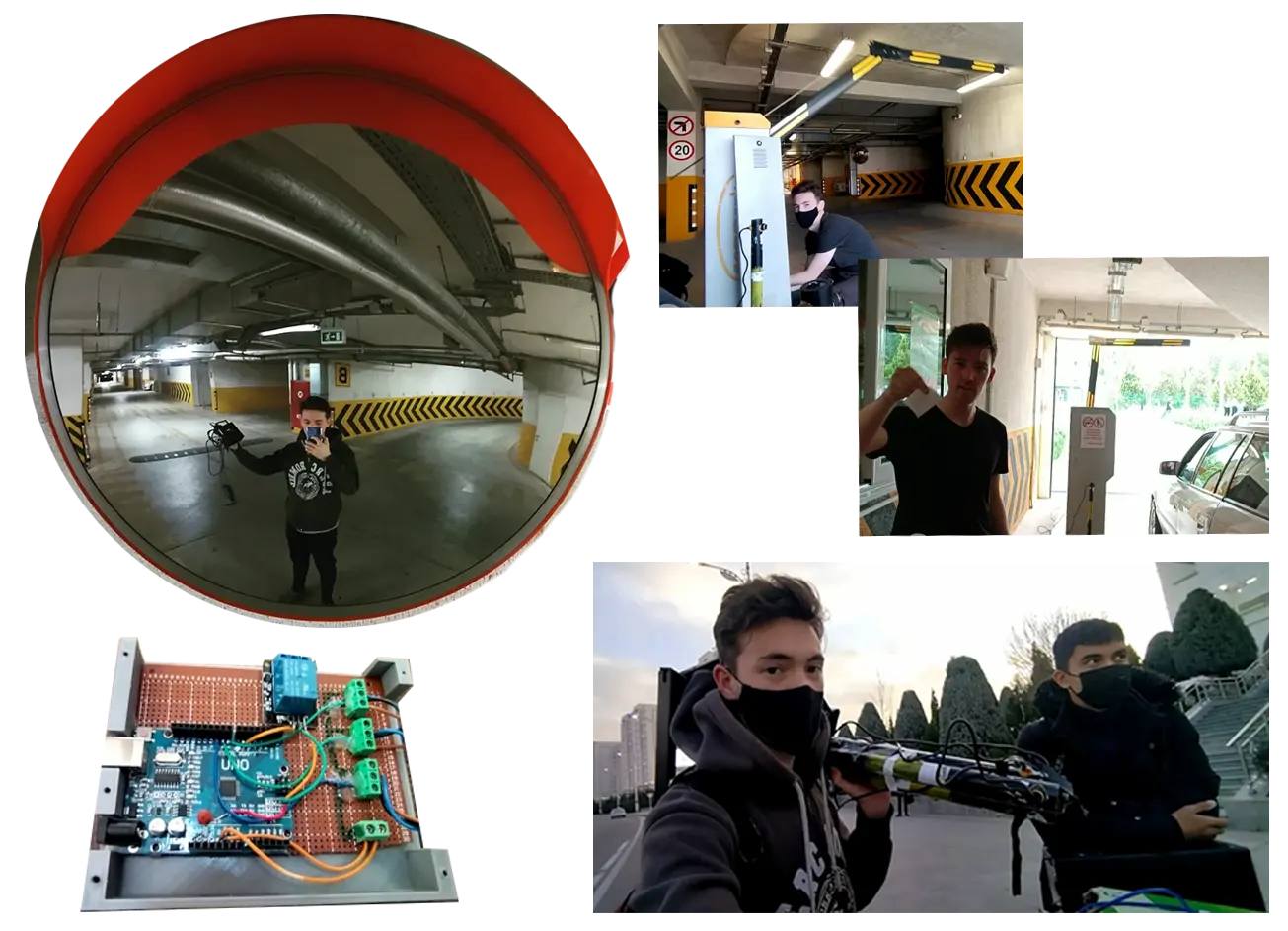
ClearParking — Small, microserviced IoT parking management system. Microservice design (connected small applications) — components are small, replaceable and independent.
Built using Python, Go, C#, JavaScript and Arduino. Each component is modular and can be swapped thanks to the microservice architecture and clean project design. UI / accounting integrations are exchangeable.
Dedicated React Web App for user-facing flows and a separate monitoring web app to watch application activity.
- There is a Resource in database with its price and all related data (totals, groups, etc.).
Res_price— price per minute for the resource.- Put the target
ResGuidinto.envwhen needed. - There should be a user account (
Rp_acc) with a registered device (QR code). EachRp_acchas fields such asRp_acc_trans_totalto reflect accumulated totals. - Entrance: scanner scans QR -> finds Device -> finds
Rp_acc-> records attendance start (AttStartDate) withAttTypeId. - Exit: scanner scans QR -> records attendance end (
AttEndDate) -> system calculates whole time used and returns the price.
Note: It supports Saphasap and AkHasap (akhsasap) schemas. Switch the
DB_STRUCTUREvalue in.envto select which schema your deployment uses.
If you don't have an attendance table, you can create it like this:
create table tbl_dk_attendance(
"AttId" int,
"AttGuid" varchar,
"EmpId" int,
"RpAccId" int,
"DevId" int,
"UId" int,
"AttTypeId" int,
"AttDesc" varchar,
"AttDate" timestamp without time zone,
"CreatedDate" timestamp without time zone,
"ModifiedDate" timestamp without time zone
);If using AkHasap schema, disable triggers in the tbl_mg_arap_attandence table to avoid duplicate logging.
- Route:
/find-device/ - Method:
POST - URL:
${hostname}${url_prefix} - Headers:
{ "Authorization": "Bearer ${token}" } - Payload:
{ "data": ${qr_data} } - urlParams:
type=["entrance", "exit"]
Responses
200 (device found)
{
"status": 1,
"data": {...ulanyjy}
}200 (device not found)
{
"status": 0,
"data": {}
}401 (unauthorized)
{
"status": 0,
"data": {}
}Example successful response (full payload)
{
"data": {
"AddInf1": null,
"AddInf2": null,
"AddInf3": null,
"AddInf4": null,
"AddInf5": null,
"AddInf6": null,
"CId": 1,
"CreatedDate": "2021-10-22 14:40:02",
"CreatedUId": null,
"DbGuid": null,
"Device": {
"AddInf1": null,
"AddInf2": null,
"AddInf3": null,
"AddInf4": null,
"AddInf5": null,
"AddInf6": "id=QP1A.190711.020,androidId=e4d788879fbe6635,baseOS=,release=10,brand=samsung,device=a7y18lte,display=QP1A.190711.020.A750FXXU5CTK1,manufacturer=samsung,model=SM-A750F,isPhysicalDevice=true",
"AllowedDate": null,
"CreatedDate": "2021-01-15 20:04:55",
"CreatedUId": null,
"DevDesc": null,
"DevGuid": "d1bddb81-2c27-4b93-b79f-5d1e5576eb78",
"DevId": 2,
"DevName": "2021-01-14 23:44:26.778464",
"DevUniqueId": "788879fbe6635",
"DevVerifyDate": "2021-01-15 20:04:57",
"DevVerifyKey": null,
"DisallowedDate": null,
"GCRecord": null,
"IsAllowed": false,
"ModifiedDate": "2021-01-21 20:52:16",
"ModifiedUId": null,
"RpAccId": 50,
"SyncDateTime": "2021-01-15 20:04:55",
"UId": null
},
"DeviceQty": null,
"DivId": 1,
"EmpId": null,
"GCRecord": null,
"GenderId": null,
"IsMain": null,
"ModifiedDate": "2021-10-22 14:40:02",
"ModifiedUId": null,
"NatId": null,
"ReprId": null,
"ResPriceGroupId": null,
"RpAccAddress": "helloworlddd",
"RpAccBirthDate": null,
"RpAccEMail": null,
"RpAccFirstName": null,
"RpAccGuid": "9d40a40d-cf50-4bbd-a7e5-733a0314beb0",
"RpAccHomePhoneNumber": "",
"RpAccId": 50,
"RpAccLangSkills": null,
"RpAccLastActivityDate": "2021-10-22 15:01:02",
"RpAccLastActivityDevice": "Browser: chrome, Platform: linux, Details: Mozilla/5.0 (X11; Linux x86_64) AppleWebKit/537.36 (KHTML, like Gecko) Chrome/91.0.4472.164 Safari/537.36",
"RpAccLastName": null,
"RpAccLatitude": 0.0,
"RpAccLongitude": 0.0,
"RpAccMobilePhoneNumber": "+99361509038",
"RpAccName": "bionicccccc",
"RpAccPassportIssuePlace": null,
"RpAccPassportNo": null,
"RpAccPatronomic": null,
"RpAccPurchBalanceLimit": 0.0,
"RpAccRegNo": "ARAK12",
"RpAccResidency": null,
"RpAccSaleBalanceLimit": 0.0,
"RpAccStatusId": 1,
"RpAccTypeId": 2,
"RpAccUName": "mike",
"RpAccViewCnt": null,
"RpAccVisibleIndex": null,
"RpAccWebAddress": "",
"RpAccWorkFaxNumber": "",
"RpAccWorkPhoneNumber": "",
"RpAccZipCode": "",
"SyncDateTime": "2021-10-22 14:40:02",
"UnusedDeviceQty": null,
"WpId": null
},
"message": "Find Device",
"total": 1
}- Route:
/set-ip/ - Method:
GET - URL params:
device_key={secret_key_of_device_in_env}
This endpoint is used by the device to update its current public IP (or local IP, as configured) — useful for remote devices with dynamic IPs.
Example:
GET /set-ip/?device_key=YOUR_DEVICE_SECRET
These endpoints return lists used by the UI for admin/monitoring:
/clearpark/attendances//clearpark/rp-accs//clearpark/devices/
Example response
{
"status": 1,
"data": "[...data]",
"message": "Info"
}Res_priceis per-minute.- Compute duration in seconds:
diff = AttEndDate - AttStartDate. - Convert to minutes and round up to the next integer minute (common parking behavior):
minutes = ceil(diff_seconds / 60). total_price = minutes * Res_price.- Always store timestamps in UTC and apply timezone conversion only at presentation layer.
Example: start 10:00:00, end 10:07:15 -> diff 435s -> 7.25 min -> ceil -> 8 minutes -> total_price = 8 * Res_price.
-
Arduino reads sensors (presence, IR, etc.) and QR/barcode scanner triggers.
-
Go-based IO interface handles barcode scanning, printing, and motor control.
- When barcode is read, Go service happily receives the read and forwards to the API.
- After checkout, Arduino runs motor to open the gate and keeps it open until car fully enters/exits (safety latch via sensors).
-
Thermal printing (tickets/receipts) and barcode scanning are accessible through the IO interface.
-
Copy
.env.exampleto.env. -
Fill required keys:
DB_STRUCTURE—saphasaporakhsasapResGuid— resource GUID for the parking serviceSECRET_KEY/JWT_SECRET— API auth- Device-specific secrets where needed (used by
/set-ip/)
-
Start services (example microservice order):
- Start DB
- Start backend API (Python/Go/C# service)
- Start React UI
- Start Arduino service (or simulator)
-
Test:
- Use
/find-device/with a QR data string indatabody andtype=entrance, thentype=exitlater.
- Use
Find device:
curl -X POST "https://example.com/api/find-device/?type=entrance" \
-H "Authorization: Bearer $TOKEN" \
-H "Content-Type: application/json" \
-d '{"data":"<QR_STRING>"}'Set device IP:
curl "https://example.com/api/set-ip/?device_key=DEVICE_SECRET"Get attendances (UI):
curl -H "Authorization: Bearer $TOKEN" "https://example.com/clearpark/attendances/"- Use HTTPS in production. Do not expose device secrets publicly.
- All API calls should be authenticated with Bearer JWT / token.
- Validate QR payloads on server-side to avoid injection.
- Keep device secrets rotated periodically.
- Log attendance events and errors to a central place for troubleshooting (centralized logging helps debugging IoT edge cases).
- If device not found: check
DevUniqueIdandDevGuidmapping intbl_device. - If price calculation mismatches: ensure both start/end timestamps use the same timezone (store as UTC).
- If duplicate attendances on AkHasap: verify that triggers in
tbl_mg_arap_attandenceare disabled (as noted above).
Clearparking connects small microservices and hardware to provide a flexible parking management system. Because of the modular design you can replace the accounting system (AkHasap, 1C, Atlant, manual CSV, etc.) or swap the UI without touching the IoT code.
Which one do you want next?